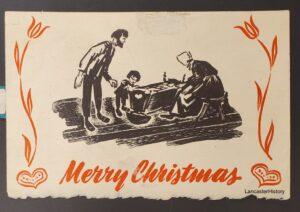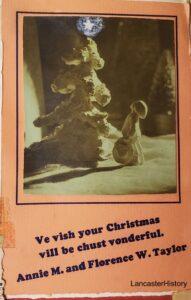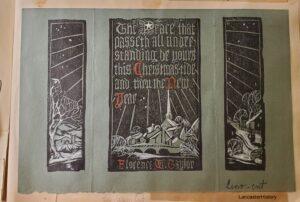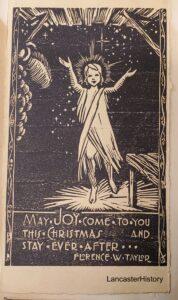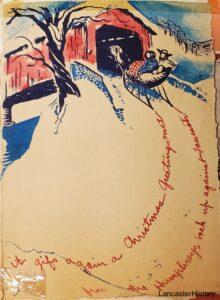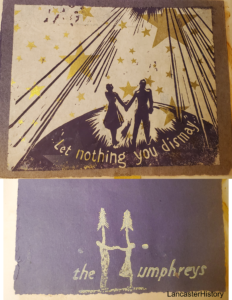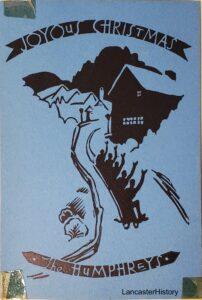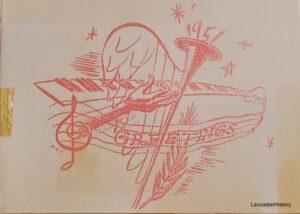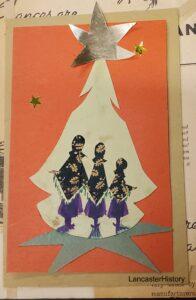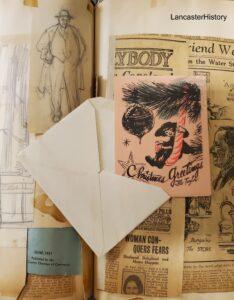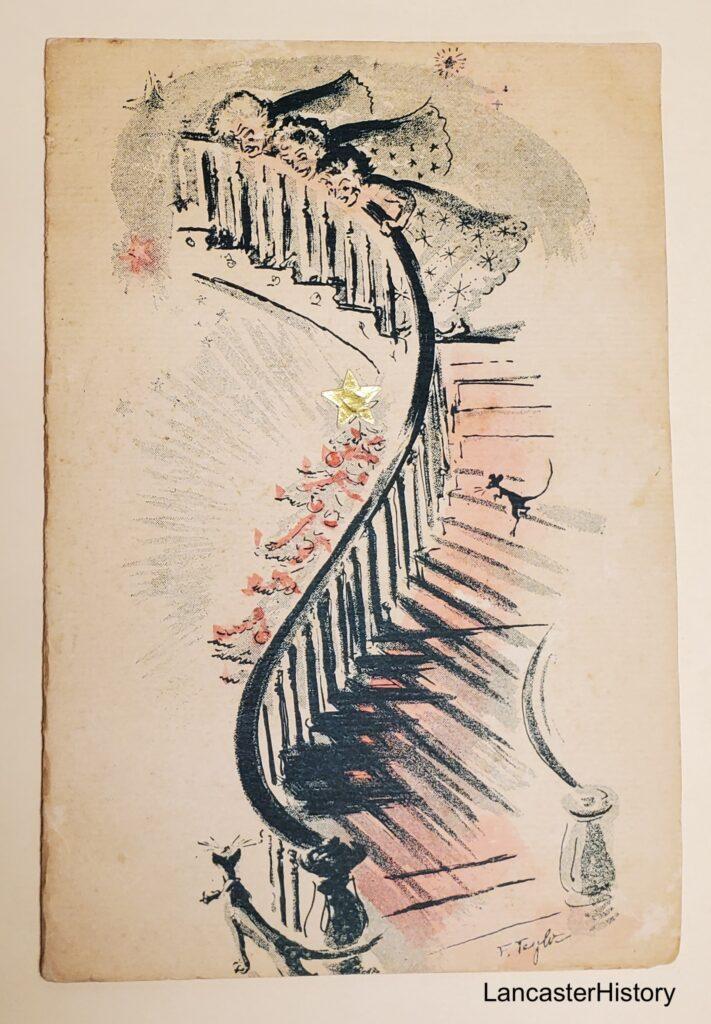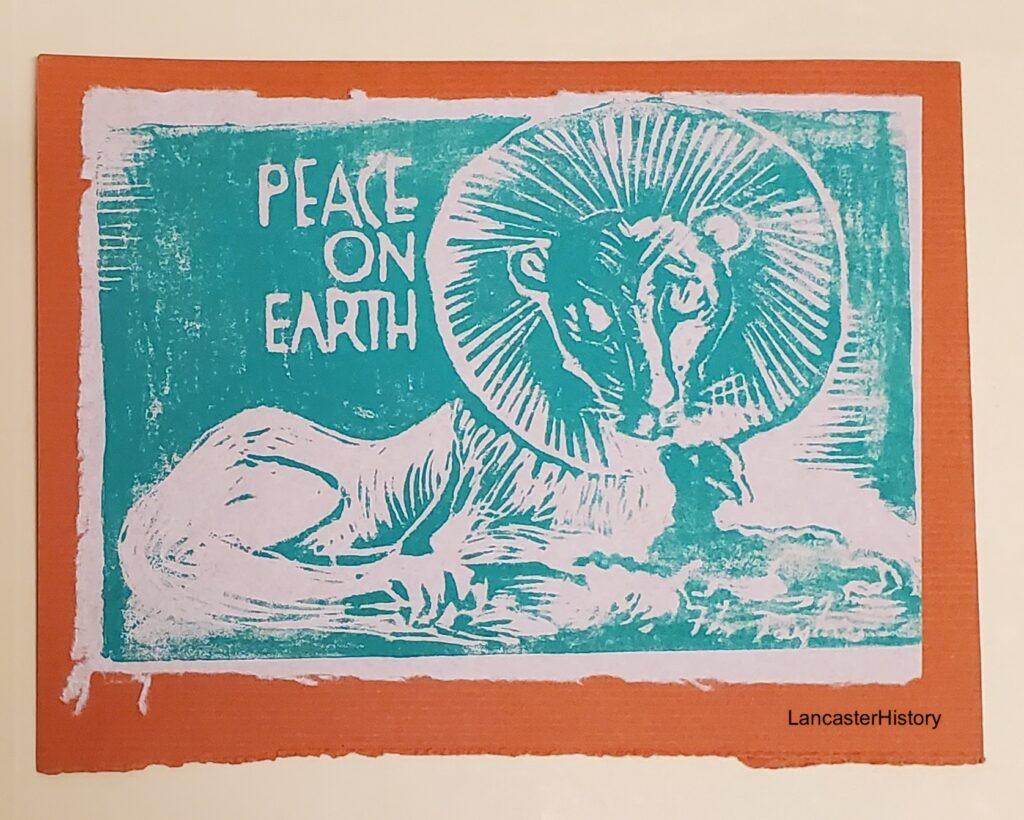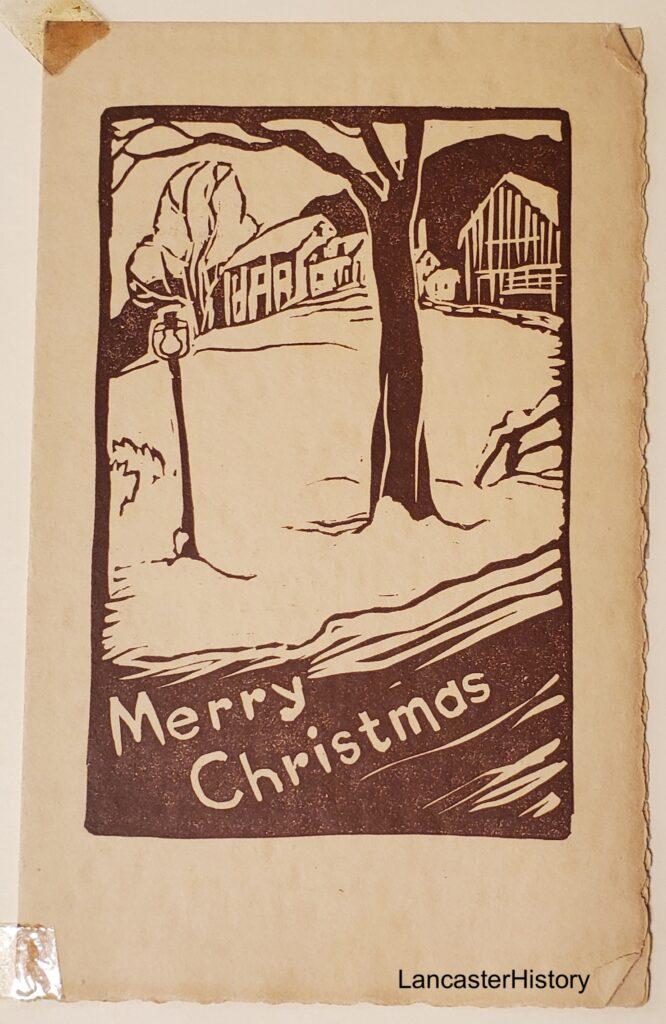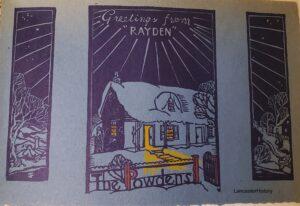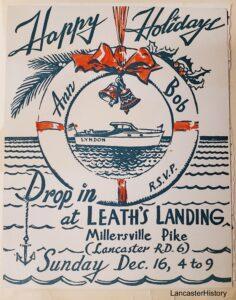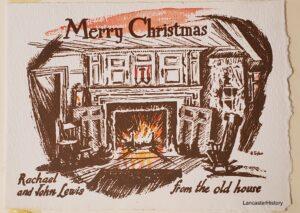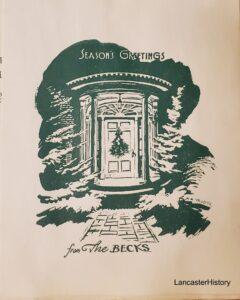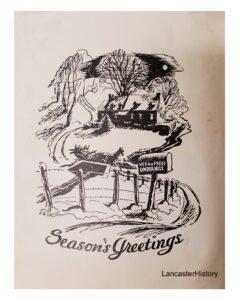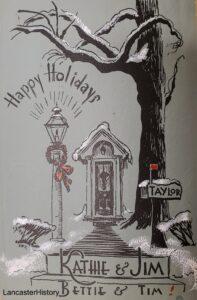Christmas Cards by Florence Starr Taylor
By Payton Becker, Curatorial Intern
My name is Payton Becker, and I am a doctoral pre-candidate in the American Studies program at Penn State Harrisburg. I grew up in Lancaster County and graduated from Lancaster Country Day School and Franklin and Marshall College with a B.A. in Classical Studies. I received my M.A. in Textile, Fashion Merchandising, and Design from the University of Rhode Island, where I focused on dress and textile history and conservation. My areas of interest are historical dress, archaeological textiles, and museum studies. Because of my background in clothing and textiles, I am particularly interested in the many dress and costume sketches and images in the Florence Starr Taylor Collection, donated by Ron and Virginia Ettelman. This is my second post on a facet of the Taylor Collection that piqued my interest. (First post can be viewed here.)
Early Christmas Cards
Florence Starr Taylor (1904-1991), a local Lancaster artist, created her own Christmas cards as well as cards for other families for many years. Florence’s own cards experimented with a variety of cardmaking methods while those made for clients were inclined to be more traditional. I found many of the Christmas cards in her personal scrapbooks that I wrote about in my previous blog post. Most cards are undated; however, her signature and information inside the card can help to determine a range of possible dates.
Two of the earliest dateable cards are shown above. The card on the left features an Amish family, a favorite subject for Florence, most likely inspired by spending several weeks in the mid-1920s boarding at an Amish farm. The return address label shows Florence living at 634 State Street when she made or sent that card. This was her home between 1927 and 1933.
The second card features a young boy starring up at the star on top of a tree with a greeting in “Dutchified” English beneath it. This card dates between 1928 and 1933 because it only includes the name of her mother Annie and not that of her father who died in November of 1928. The card also includes the name Florence W. Taylor (the W. stood for Waters), her given name until her marriage to Harry Humphreys in 1934. Until their divorce in 1945 she used the name Florence T. Humphreys. For the remainder of her life she used the name Florence Starr Taylor. Starr was the last name of her paternal grandmother.
Early Linotype Christmas Cards
These two cards, both signed Florence W. Taylor most likely date from the late 1920s until her marriage to Harry Humphreys in 1934. They are both Linocut cards, featuring wintry religious scenes. Linocut printing involves carving a design into a sheet of linoleum, inking it, and pressing it onto paper to transfer the image. In the first example, Florence added additional color to the black print with green paper as well as red and white details.
Humphreys Family Christmas Cards (1934-1944)
These three Christmas cards date from the period of Florence’s marriage to Harry Humphreys. The card on the left is dated 1941. The other two cards are undated. The 1941 card features a covered bridge and Amish couple in a horse-drawn sleigh. These were subjects common in Florence’s art and the card would easily be recognized as Florence’s work by those who knew her. The first undated Humphreys card is a print featuring a hand-holding couple, likely Florence and Harry, with golden stars above them. The inside of the card is stamped “The Humphreys” where the couple forms an “H” with outstretched hands while each holds a raised Christmas tree with their other hand. This unique signature shows that Florence was thinking about the inside of the card just as much as the outside. The second undated Humphreys card features the entire Humphreys family silhouetted on a sled.
A Selection of Post-1945 Christmas Cards
These three cards date from the period following Florence’s divorce from Humphreys. The card dated 1951 on the far left is musically inspired and has a different style to the previous cards. Its red ink, overlapping objects, and thin lines set it apart from her earlier cards. The card in the center dated 1952 is even more distinctive – a multimedia card card with layered paper, stickers, and ink drawings. The inside reads, “Amish yet we may not be; But Taylor Frau’n all are we; Hoping this vonderful Christmasy; Feeling is yours thru ’53!” The greeting indicates that it is a card from the Taylor family and not just Florence. While it may appear less elegant than the others, this type of card would have taken longer to make since it would have been made individually each time rather than printed. The three figures in the tree likely represent Florence, her sister Madge, and her mother Annie. The Christmas card on the right marks a return to a traditional printed card. Dated 1968, the card features a whimsical print, colored with green and red watercolor paint. We also see Florence’s nickname, Flo, for the first time on a Christmas Card.
Some Undated Florence Christmas Cards
The card on the left features three women on a stairway peering down at a Christmas tree. Notice the whimsical mouse on the steps! The women are likely Florence, her sister, and her mother. This one is difficult to date because Florence doesn’t include a middle initial in her signature, so it could be from before her marriage (1928-1933) or after her marriage and before her mother died (1945-1960). Perhaps it was from 1951 or 1953, since Florence has used the same gold star sticker as her 1952 card! The card in the middle is another Lino-cut card. In this instance, Florence leaves out her middle initial but again uses her nickname “Flo.” The card on the right is a Lino-cut print snowy scene and while it does not include Florence’s signature we can suppose that it was made by her because it matches her style and was found in one of her scrapbooks. The absence of her signature or human figures makes it difficult to date.
Freelance Christmas Cards
In addition to her personal and family cards, Florence produced cards for other families as part of her freelance work. These are all Lino-cut cards in Florence’s style, featuring the names of the families but not usually the year. The Powdens Family Christmas card is very reminiscent of one of Florence’s earlier Lino-cut cards and is perhaps also from the pre-1934 period. The card for the Becks includes Florence’s signature with a star instead of a middle initial, indicating it is from the period following her divorce in 1945. Also sporting the star signature is a Christmas card Florence made for her younger brother, James (aka Jim), and his family. Unlike the other doorway cards, she takes the time to add colored details with red and white paint
Florence clearly had a love and affection for making Christmas cards. She often used homes, front doors and interiors to express her belief that houses reflect the personalities of those who reside in them. Speaking at the November 15, 1954 meeting of the Pennsylvania Guild of Craftsman, Conestoga Valley Chapter she simply stated, “your Christmas card must represent you.”[1] So what represents Florence? It seems to me that the illustrations and themes in the cards above clearly reflect Florence’s love of family, the Amish, wintry landscapes and reflect her passion for whimsey, art, and life!
[1] “Craftsmen Hear Artist Speak on Christmas Cards.” Intelligencer Journal (Lancaster, PA), Nov. 16, 1954.
From Florence and LancasterHistory – Happy Holidays!
From Object Lessons

